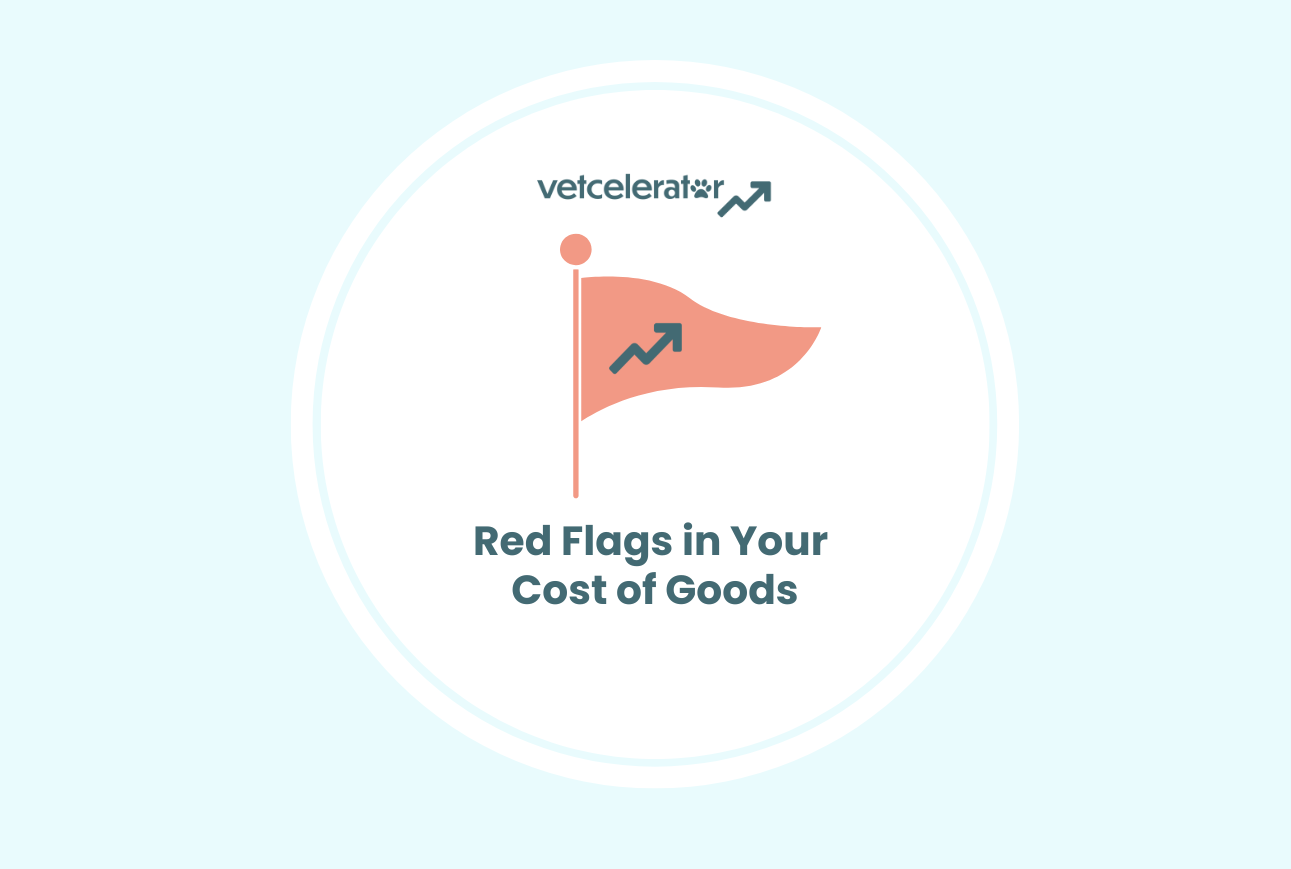
On the profit and loss statement (P&L), veterinary cost of goods and labor are the two most critical expense categories that influence profitability for a veterinary practice: Cost of Goods Sold and Labor. These two categories make up the vast majority of your expenses. This series from Vetcelerator will feature how to think about the challenges of managing the cost of goods sold (COGS) at your veterinary clinic. The table of contents for what’s to come is as follows:
Financial Oversight for Your Veterinary Clinic or Pet Brand
There are several key issues to be aware of when addressing inventory management and pricing as a veterinary practice manager or owner. Below is a list of common red flags to be aware of when considering COGS for your veterinary clinic.
Overstocking Your Veterinary Clinic Pharmacy
Over-ordering may seem like a cautious approach, but it often leads to wasted stock and lost revenue. If your shelves are full all the time, your pricing strategy and ordering habits might be overdue for a review. Avoid tying up cash in unsold products by staying alert to these signs that your vet clinic is overstocked.

1. Pharmacy Items Sit on the Shelf or Fridge for Longer Than Three Months
We expect the majority of pharmaceutical inventory to be off of the shelf and reordered with varying frequency. That cycle should not take longer than 3 months. The majority of items ordered should be off the shelf in less than a month.
If long shelf lives are occurring, we see it as a red flag for:
- Over-Ordering: Ordering more products than you are able to sell, either by volume or by type.
- Underutilization: Not selling what you have in stock. If this is occurring for a particular product at your veterinary clinic, it may be time to phase that product out.
Want to know more about client purchase consideration? Read Revisiting Competition and Purchase Consideration.

2. No Stock-Outs or Never Running Out of a Product
If you never run out of an item, especially during high demand, you are likely over-ordering. Over-ordering on a frequently used product can lead to poor turnover when that product is no longer in high demand at your clinic.

3. Always Buying the Largest Quantity of a Product
While buying in bulk is often cheaper at checkout, slow product turnover costs your vet clinic more in the long run. We recommend ordering the smallest quantity of a new product to start and then escalating based on sales data over time.

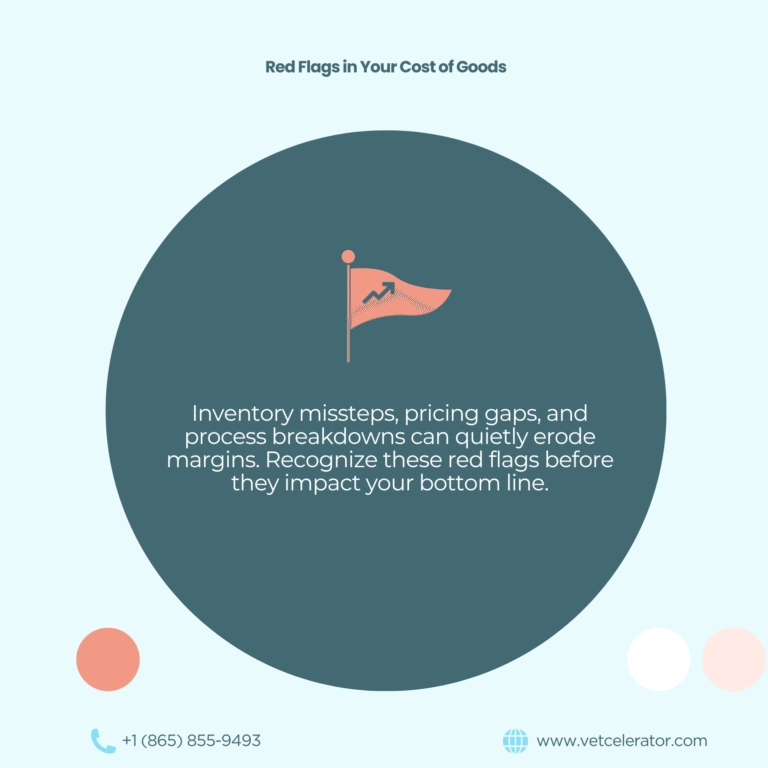
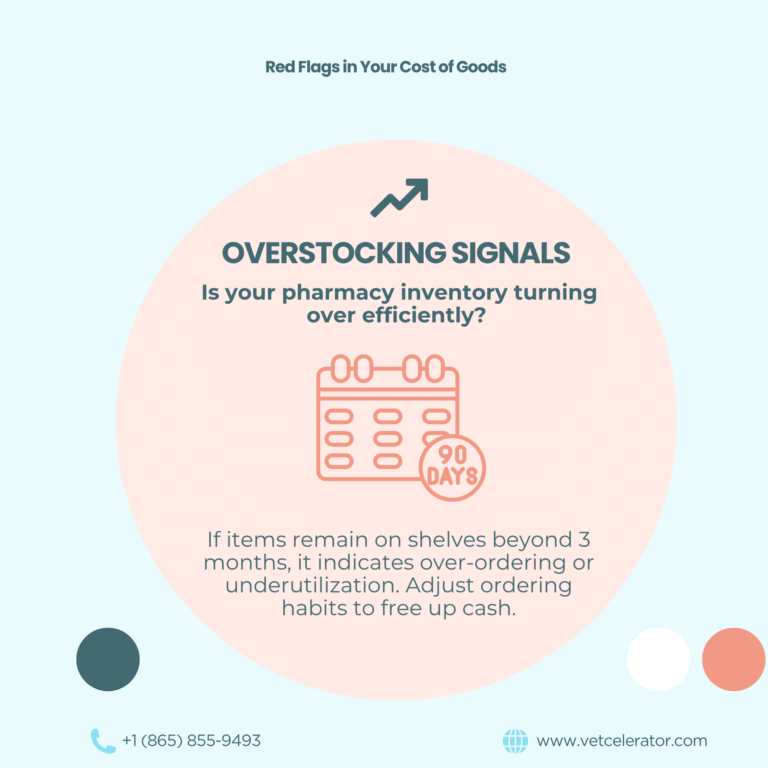
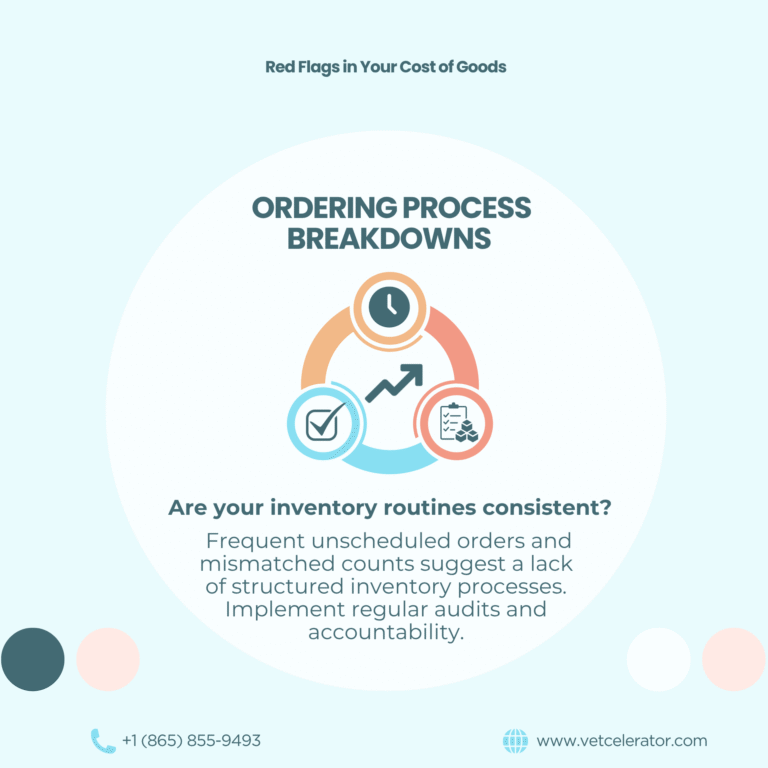
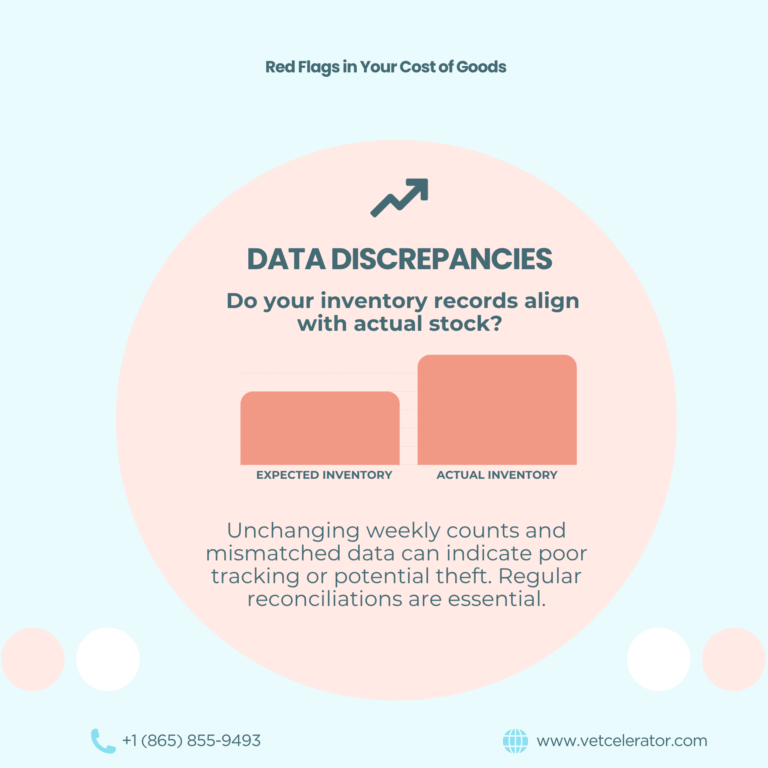
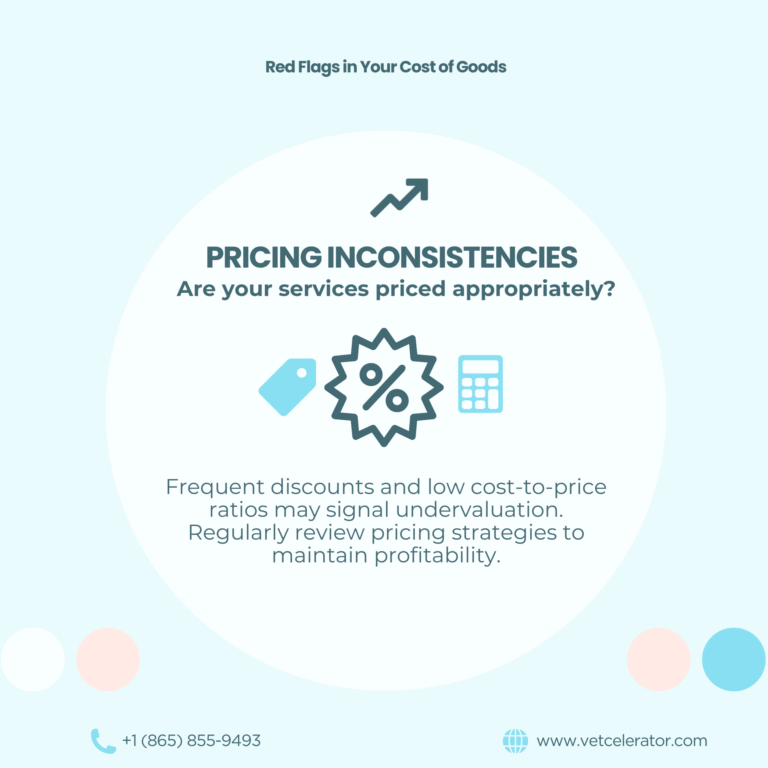

Process Failures and Signs of Broken Inventory Systems
A strong veterinary inventory management process is necessary to maintain accurate COGS and operational stability. When inventory routines are missing or ignored, costly mistakes follow. These red flags highlight the need for consistent procedures that improve the veterinary cost of goods accuracy and support smarter buying.

1. Not Having a Count Process in Place
Inventory management is the key to low COGS and a healthy clinic. If no such process has been established, or if that process is not being followed, then you should create an inventory process as well as a system of accountability. Not having a system in place can lead to more mistakes in the inventory process and financial issues for your practice.

2. Frequent Unscheduled Ordering
We expect veterinary clinics to order at the frequency of once per week. If a location is constantly ordering more frequently or if the order schedule is sporadic, then the inventory management process should be reviewed. Clinics who order frequently without a schedule often do not have an inventory management process in place.

3. Inventory Counts Are Not Matching Expectations
If your expected At-Hand amount is different than what is actually in stock, this may be a symptom of:
- Poor Inventory Management: The process for predicting your amounts may not be effective. You can always check your actual sales in Rhapsody to confirm your predictions and expected counts.
- Theft of Product: If counts are consistently off from predicted amounts and your sales match your predictions, you should review with your team on possible theft of product.
Data Discrepancies: Inventory Management Red Flags

Inventory data mismatches can significantly affect your veterinary cost of goods, pointing to deeper process or compliance issues, from poor tracking to possible theft. Trustworthy numbers are the backbone of any solid Cost of Goods Sold analysis. Spotting these discrepancies early safeguards your bottom line and fine-tunes the pricing strategy at your clinic or pet facility.

1. Unchanging Weekly Counts
If your clinic’s inventory count is always the same, you may be experiencing:
- Poor Inventory Management: Your inventory management process is likely not being adhered to by your veterinary team. We see this frequently when a team copies count information from the previous week in lieu of doing the count properly.
- Underutilization: If the product is genuinely not moving or if you are always ordering to keep yourself at the same level, review the way you are ordering. It may be time to phase out some products or to promote others to pet owners.
- Over-Ordering: Sometimes, an unchanging product count results from always ordering the same amount. If you are not seeing fluctuations in stock, order less of a product and see if it moves.
- Theft of Product: If the count is always the same, we have to consider that it may have been falsified to cover for theft. Always check your counts with your At-Hand expectations.

2. Mismatched Inventory Data
If the inventory usage report at your veterinary clinic does not match your count (either by selling more than you count as in-stock or ordering more than you sell), this is a red flag for:
- Theft of Product: If the data does not match the count, you could be missing a product.
- Poor Inventory Management: Your count could be incorrect.
- Over-Ordering: If you are ordering inventory at levels that surpass sales, you are over-ordering.

3. Missing Count Items
If an item was ordered and it is not listed in the count, it is a red flag for theft of product.
If an item was counted previously and is missing from the count now, it could be:
- Theft of Product: Unless there was a previously discussed item discontinuation, this is a sign that the product has been removed via theft.
- Poor Inventory Management: If the count is being mismanaged by your veterinary team or if the order is not being submitted based on the count, then it is an indicator that the inventory management strategy needs review.
Pricing Red Flags That Affect Veterinary Cost of Goods
Your pricing strategy matters when managing COGS and sustaining clinic profitability. Frequent discounts, unusually low price ratios, or the absence of pricing feedback from clients can all signal deeper issues. Regular audits and adjustments support better financial oversight for vet clinics.

1. Consistent and/or Frequent Discounting
Discounts are to be applied sparingly and at the discretion of the clinic owner or practice manager. If discounts are being applied inappropriately at your vet clinic, it is a red flag for theft of services and abuse of the system.

2. Consistently Discounted Items
If an item is receiving a manual discount frequently, it is either an opportunity to reevaluate the pricing of said item to better suit your market costs or a red flag that there is some theft of services and theft of product occurring.

3. No Client Pricing Complaints
While this may seem counterintuitive, if you never receive a complaint on pricing, then your prices are likely too low. A pricing review or audit may be needed to establish a better pricing scheme for your location.

If the price of a non-preventative medication is lower than a ratio of 2.5, you are likely charging too little for that medication.

5. Low Cost to Price Ratios on Lab Testing
If the price of a lab test is lower than a ratio of 2, you are likely charging too little for that test. The exception to this would be regularly recurring bloodwork for special cases.
Your Next Step to Smarter Veterinary Cost Management

Addressing issues in your veterinary cost of goods is about building a financially stable clinic that can grow confidently. Whether it’s over-ordering, pricing inconsistencies, or data discrepancies, each red flag signals that your systems need more structure and support.
If your practice is seeing any of the signs outlined above, it’s time to take the next step toward better financial performance. Join Vetcelerator’s no-cost GPO and access exclusive savings, more innovative inventory solutions, and the operational guidance your clinic needs to thrive. We help veterinary clinics streamline purchasing, reduce overhead, and optimize cost of goods with clarity.
Don’t just track your inventory, manage it with purpose. Join the Vetcelerator GPO.


